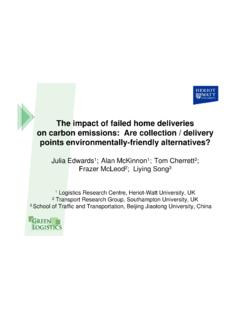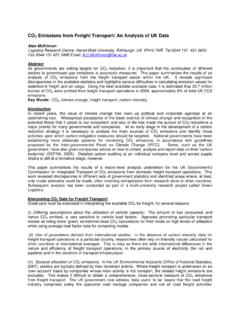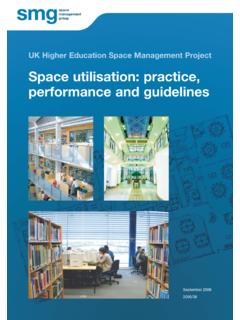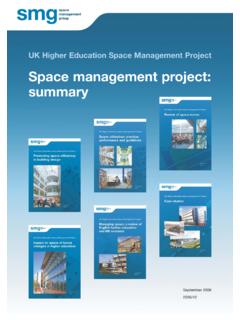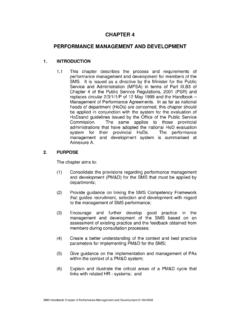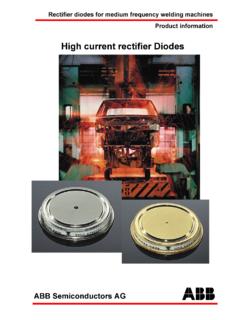Transcription of A Literature Review - Green Logistics
1 - 1 - TRANSPORT MANAGEMENT A Literature Review Heriot-Watt University January 2007 Green Logistics Project Work Module 1 - 2 - ABSTRACT Purpose The purpose of this paper is to Review Literature relating to vehicle utilisation , transport optimisation and the implementation of Green transport management measures within the freight industry with a view to minimise the negative impact of road freight transport on the environment. Design/Methodology/Approach This report first reviews the key constraints on vehicle utilisation , before examining opportunities to optimise transport operations. Within the remit of this report, three key areas for improved efficiencies within the industry are identified: logistical efficiency, vehicle utilisation and driver training and behaviour.
2 Search terms: Green Logistics ; transport management; vehicle utilisation ; transport optimisation. Findings Environmental issues will increasingly influence the way transport managers do their jobs. Currently, there is a growing field of governmental Literature offering advice and guidance. Research Limitations/implications The scope of this Review is limited by the availability of Literature and time. As a broad study, it does not present the full range of Literature on the state of Green transport management, but attempts to give an overview of the main concerns and areas for improvement. The text and case studies are illustrative of the previous work done in this field. Practical implications This report highlights limitations faced by transport managers in attempting to operate vehicles efficiently and draws together environmentally-related Literature that offers guidance to transport managers.
3 Originality/value As a Literature Review it aims to synthesise previous work rather than develop new perspectives. It should provide a foundation for future research in this field. - 3 - CONTENTS 2 - 3 - 5 - 5 - 1. 6 - 2. KEY PERFORMANCE INDICATORS & ISSUES: Measuring vehicle utilisation & 7 - Measures applicable to both macro- and micro-level 7 - Tonne-kilometres per vehicle per annum (tkm)..- 7 - Weight-based loading 7 - Empty 8 - Lading 10 - Measures applicable to micro-level 11 - Space- utilisation / vehicle 11 - Productive 12 - Efficiency of vehicle usage (tkm/mkm)..- 13 - Overall Vehicle Effectiveness (OVE)..- 13 - 3. KEY CONSTRAINTS / ISSUES FOR VEHICLE 14 - Sourcing, distribution and 14 - Demand 14 - Just-in-Time (JIT) 15 - 16 - E-commerce and the growth of home 17 - Priority given to the outbound delivery 17 - Unreliability of delivery schedules: 18 - Unitisation: unit 19 - Vehicle size and weight 19 - Incompatibility of vehicles and products: 19 - Warehouse configuration and interface 20 - Handling and packaging 21 - Industry 23 - Lack of support from Senior 23 - Government regulations.
4 - 23 - 4. POTENTIAL EFFICIENCY IMPROVEMENTS IN THE FREIGHT INDUSTRY: LOGISTICAL 25 - Sourcing, distribution and 25 - Local 25 - 26 - 27 - More transport-efficient order and sales 27 - Unattended 28 - 29 - Collaboration & 29 - Use of primary consolidation 29 - Data sharing: collaboration & network 30 - - 4 - Reverse 30 - Efficient unit 31 - 31 - Enhanced status of transport managers within the supply 32 - 5. POTENTIAL EFFICIENCY IMPROVEMENTS: VEHICLE 33 - Fuel 33 - Alternative 33 - Driver 34 - Aerodynamic 36 - Rolling 36 - Aerodynamic 37 - Vehicle 39 - Enhanced capacity within current EU regulations: Double-deckers (DD)- 39 - Increasing permitted EU weights & dimensions: Longer, heavier 41 - 6.
5 CONCLUSIONS & KEY OUTSTANDING 44 - 45 - - 5 - TABLES & FIGURES TABLES 1. Percentage empty running .. - 8 - 2. Lading factor by vehicle type in 2005 ..- 10 - 3. Summary of KPI findings for the Freight Best Practice Programme .. - 14 - 4. Emissions (per vehicle km) in urban areas ..- 20 - 5. Calculation of weight utilisation for different tertiary types .. - 22 - 6. Comparative LHV characteristics for Robinson s & Denby s rig .. - 42 - FIGURES 1. Weekly demand pattern for one of the major UK-based producers ..- 15 - - 6 - 1. INTRODUCTION Offering the greatest flexibility in terms of timings and destinations compared with other modes, road transport dominants freight distribution in the UK ( of all goods transported (tonne-kms) in 2005 was carried by road) (Department for Transport, 2006a).
6 In moving this amount of freight by road, companies use 11 billion litres of fuel and produce 28 million tonnes of CO2 each year (Freight Transport Association, 2003), or approximately 5% of total CO2 emissions in the UK (McKinnon, 2007). Aside from the direct negative effects of greenhouse-gas emissions, freight traffic contributes to increased noise levels, congestion and accidents. Current forecasts suggest that the number of truck-kms will increase by 10-11% between 2000 and 2010 (Department for Transport, 2006a). It is against this backdrop of projected growth and associated environmental impacts that the government has set objectives for improving environmental performance of freight transport by improving vehicle efficiency, minimising congestion, making better use of road infrastructure and reducing greenhouse gas emissions (Department for the Environment, Transport and the Regions, 1999a).
7 Within this context, the European Commission highlights five main approaches to the adoption of environmental concerns in freight transport (European Commission, 2001). 1. Reducing the impact of freight through cleaner, alternative fuels and improved truck design; 2. Driver training and behaviour; 3. Improving vehicle utilisation by increasing load factors, utilising new information technology, improving routing and collaboration between companies; 4. Switching to more environmentally-friendly modes; & 5. City Logistics . - 7 - This report considers the first three EC approaches, and will examine the optimisation of transport, the utilisation of vehicles and associated transport management decisions. The rest of this report is organised as follows: Section 2 outlines key performance measures associated with vehicle utilisation ; Section 3 highlights constraints on the optimisation of freight transport; Sections 4-5 considers various efficiency measures aimed at either reducing fuel consumption or maximising vehicle use and Section 6 draws conclusions and makes suggestions for future research.
8 2. KEY PERFORMANCE INDICATORS & ISSUES: Measuring vehicle utilisation & efficiency In order to understand the issue of vehicle utilisation , it is first necessary to understand how such utilisation can be measured. There are various indices that can be used to calculate the utilisation of vehicle fleet, each giving a different impression of transport efficiency. Measures applicable to both macro- and micro-level data Tonne-kilometres per vehicle per annum (tkm) This main indicator of freight demand is essentially a productivity indicator, and as such, generally presents the trucking industry in a favourable light. Over the last half century average annual amounts of work undertaken by trucks has increased five-fold, mainly as a result of hauliers taking advantage of increases in maximum truck weight and vehicles being used for more hours in the day (McKinnon, 2007).
9 Since the late 1990s this metric has levelled off for the UK lorry fleet (Department for Transport, 2006b). A limitation of this indicator is that no account is taken of the utilisation of vehicle carrying capacity (L onardi & Baumgartner, 2004). Weight-based loading factor This measure is generally expressed as the ratio of the actual weight of goods to the maximum weight that could have been carried on a laden trip. It gives a less-favourable impression of the industry as average load factors have declined in - 8 - this country from 63% in 1990 to 57% in 2005 (Department for Transport, 2006a). Again, a limitation of this ratio is that being exclusively weight-based, this ratio can only be described as a partial measure. The use of vehicle space / deck area should be considered to give a more realistic assessment.
10 Empty running Transport managers have to make quite difficult decisions regarding the loading of vehicles, owing to the almost exclusively one-directional movement of freight consignments from point of production to point of consumption. The challenge in the freight industry is to find backloads for returning vehicles, by making use of spare capacity on the return leg of a delivery journey (McKinnon & Ge, 2006). Yet it seems that empty running is inherent in the freight industry (Gorkie, 2006). Not only does the returning empty vehicle represent a wasted resource in economic terms, but such a journey is increasingly seen as having an environmental consequence (Department for the Environment, Transport and the Regions, 1999a). For instance, Table 1 illustrates that empty running for all goods vehicles in 2005 was (Department for Transport, 2006a), representing 6,103 million kilometres when vehicles were driven unladen, but were contributing to noise and air pollution, congestion, and health and safety issues.
